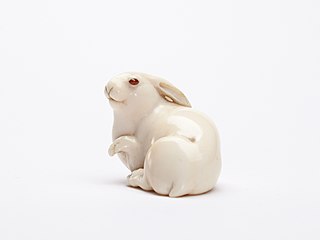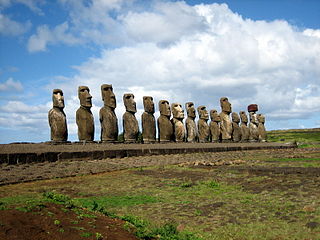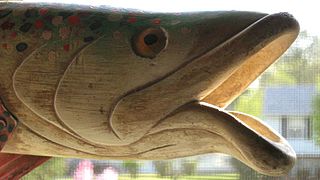Related Research Articles

Wood carving is a form of woodworking by means of a cutting tool (knife) in one hand or a chisel by two hands or with one hand on a chisel and one hand on a mallet, resulting in a wooden figure or figurine, or in the sculptural ornamentation of a wooden object. The phrase may also refer to the finished product, from individual sculptures to hand-worked mouldings composing part of a tracery.

A netsuke is a miniature sculpture, originating in 17th-century Japan. Initially a simply-carved button fastener on the cords of an inro box, netsuke later developed into ornately sculpted objects of craftsmanship.

Stone carving is an activity where pieces of rough natural stone are shaped by the controlled removal of stone. Owing to the permanence of the material, stone work has survived which was created during our prehistory.

A Dalecarlian horse or Dala horse is a traditional carved, painted wooden statue of a horse originating in the Swedish province of Dalarna (Dalecarlia). In the old days the Dalecarlian horse was mostly used as a toy for children; in modern times it has become a symbol of Dalarna, as well as of Sweden in general. Several types of Dalecarlian horses are made, with distinguishing features common to the locality of the site where they are produced. One particular style has, however, become much more common and widespread than others. It is stoutly carved and painted bright red with details and a harness in white, green, yellow and blue.

Alebrijes are brightly colored Mexican folk art sculptures of fantastical (fantasy/mythical) creatures. The first alebrijes, along with invention of the term, originated with Mexico City cartonero Pedro Linares. Linares often told that in the 1930s, he fell very ill, and while he was in bed, unconscious, he dreamt of a strange place resembling a forest. There, he saw trees, animals, rocks, clouds that suddenly turned into something strange, some kind of animals, but, unknown animals. He saw a donkey with butterfly wings, a rooster with bull horns, a lion with an eagle head, and all of them were shouting one word, "¡Alebrijes!, ¡Alebrijes!". Upon recovery, he began recreating the creatures he saw in cartonería, a papercraft consisting of strips of paper and glue on an armature.

Wood carving is one of the oldest arts of humankind. Wooden spears from the Middle Paleolithic, such as the Clacton Spear, reveal how humans have engaged in utilitarian woodwork for millennia. Indeed, the beginnings of the craft go so far back that, at least where timber is present, the use of wood exists as a universal in human culture as both a means to create or enhance technology and as a medium for artistry. The North American Indian carves his wooden fish-hook or his pipe stem just as the Polynesian works patterns on his paddle. The native of Guyana decorates his cassava grater with a well-conceived scheme of incised scrolls, while the native of Loango Bay distorts his spoon with a design of figures standing up in full relief carrying a hammock. Wood carving is also present in architecture.

A Stone sculpture is an object made of stone which has been shaped, usually by carving, or assembled to form a visually interesting three-dimensional shape. Stone is more durable than most alternative materials, making it especially important in architectural sculpture on the outside of buildings.

Eric Thorsen is an American painter and sculptor known for his wildlife sculpture and fish carvings which have won him multiple awards at major art shows nationwide including "Best In World" at the 1992 World Taxidermy & Fish Carving Championships. At age 24 he is the youngest recipient of this award. Breakthrough magazine described him as "More than Promising" and his work has "an uncanny realism". Thorsen has appeared on TV shows and YouTube and his artwork can be found in prominent public spaces, private collections, and on product labels. He has been commissioned to create artwork for corporate entities such as Nike Inc.,Lowe's, Coca-Cola, Walt Disney Attractions, Inc. and national non profit groups. He is a resident of Bigfork, Montana.

A duck decoy is a man-made object resembling a real duck. Duck decoys are sometimes used in waterfowl hunting to attract real ducks.

The Dorset House is an exhibit building at Shelburne Museum in Shelburne, Vermont, United States; it houses the museum's collection of 900 wildfowl decoys.

Toi whakairo or just whakairo (carving) is a Māori traditional art of carving in wood, stone or bone.

Kwakwaka'wakw art describes the art of the Kwakwaka'wakw peoples of British Columbia. It encompasses a wide variety of woodcarving, sculpture, painting, weaving and dance. Kwakwaka'wakw arts are exemplified in totem poles, masks, wooden carvings, jewelry and woven blankets. Visual arts are defined by simplicity, realism, and artistic emphasis. Dances are observed in the many rituals and ceremonies in Kwakwaka'wakw culture. Much of what is known about Kwakwaka'wakw art comes from oral history, archeological finds in the 19th century, inherited objects, and devoted artists educated in Kwakwaka'wakw traditions.

A fish decoy is an object in the shape of a fish or some other animal that is used as a decoy to attract fish. It is often used during ice fishing. Unlike a fishing lure, a fish decoy doesn't have a hook.

The Chen Clan Ancestral Hall or Chen Clan Academy is an academic temple in Guangzhou, China, built by the 72 Chen clans for their juniors' accommodation and preparation for the imperial examinations in 1894 in Qing Dynasty. Later it was changed to be the Chen Clan's Industry College, and then middle schools afterward. Now it houses the Guangdong Folk Art Museum.

William "Jesse" Ramey is a vintage master carver of fish decoys. His work is sometimes attributed to "Jess Ramey", though he was known to his friends as Jesse. His work, along with Oscar W. Peterson's, formed the basis of what is now considered the "Cadillac style".
Oscar W. "Pelee" Peterson (1887–1951) was an American carver of fish decoys.
Oscar "Pelee" Peterson is among the best known and most widely imitated fish carvers.

Griffon E. Ramsey is an American chainsaw carving artist known for her pop-culture wood sculptures which have appeared at the Australian Chainsaw Carving Championships and the Butler Chainsaw Carving Invitational. Chip Chats magazine described her as a "world-famous" artist with an, "edgy and bold style" while VICE and Uproxx called her a "rock star of the art world" and noted her status as a female in a largely male-dominated field.
Philip "Peter" Peltz was an American artist, active in Sandwich on Cape Cod, Massachusetts. He was known for his wooden, painted carvings of birds mounted on driftwood.

Ira Hudson was an American boat builder and prolific decoy and shorebird carver from Chincoteague, Virginia. He created over 20,000 decoys during his lifetime, full sized and miniatures.
Owen Yalandja is Aboriginal Australian carver, painter and singer of the Kuninjku people from western Arnhem Land, Australia. A senior member of the Dangkorlo clan, who are the Indigenous custodians of an important site related to female water spirits known as yawkyawk, Yalandja has become internationally renowned for his painted carvings of these spirits, as well as his paintings on eucalyptus bark.
References
- ↑ Matt Bewley Phillips's love of carving goes back to 1950s when he was a Scout Archived 2009-03-25 at the Wayback Machine The Daily Journal March 29, 2007 Fergus Falls Journal
- ↑ Scott Tedrick Time to Meander Archived 2011-07-11 at the Wayback Machine Advocate Tribune (Granite Falls News.com)
- ↑ Events calendar